Last updated on February 13, 2024
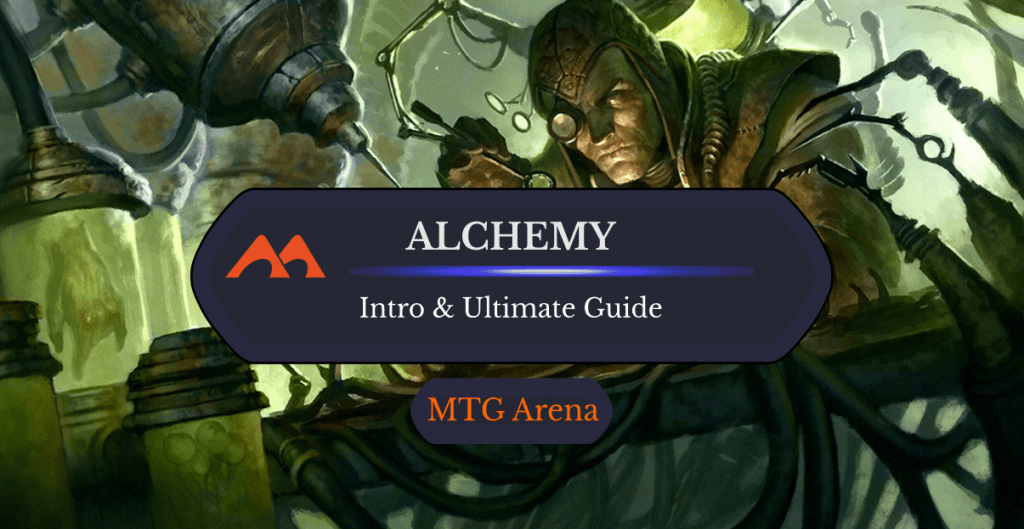
Forbidden Alchemy | Illustration by David Rapoza
Picture if you will, a mad scientist or wizard brewing up a solution, tweaking this and that, adding pinches of bits and turning down the heat. What concoction is coming from this laboratory? Who will test it you ask? Let's stop there and get into the topic for today: Alchemy. It is only on Magic Arena, and relatively young as far as formats go. If you have questions about anything from rules and legal cards, to how it affects other digital-only formats, or are just curious, then read on.
There are a lot of messy implications when it comes to a digital-only format, especially one that impacts other digital-only formats like Historic and Timeless. There’s quite a bit of confusion and controversy, and the best way to have an informed opinion is to be, well, informed.
Let’s dig in!
What Is the Alchemy Format?

Frenzied Geistblaster | Illustration by David Auden Nash
The Alchemy format is a Magic Arena play mode, like Standard, that includes digital-only cards. It is subject to periodic rebalancing of cards instead of a ban list, and the rebalanced cards do not affect Standard.
Why Was Alchemy Created?
Alchemy was made to create a fresher, still rotating, Standard format that benefits from the ability to make direct changes to digital-only cards.
WotC said they design for Alchemy with a new perspective on older challenges and want it to stay fresh and adaptable.
This gives players a sort of second Standard to play where all the cards they already own are legal, but with some tweaks to powerful build-arounds. It essentially extends the format’s lifetime because you can play in a format where the most powerful decks likely aren’t as popular thanks to changes to their key pieces.
It also allows Wizards to make changes to Standard that aren’t possible in paper, like rebalancing cards instead of outright banning them. There is some cause for concern with this since it creates some confusion among players and causes digital players to have to buy into the format to get new cards.
Alchemy-Legal Sets
Any Standard set from Alchemy: Innistrad onward is legal in Alchemy until its two-year rotation. Sometimes, new supplemental sets become legal in the format. The sets are generally as small as 30 cards and feature some unique mechanics designed specifically for digital play.
All of the base set, Arena-exclusive cards are also playable, including cards like Hallowed Priest and Siege Dragon.
Here’s a current list of all the sets that are legal in Alchemy in addition to the Arena Base Set:
- Dominaria Remastered
- Alchemy: Dominaria
- The Brothers' War
- Alchemy: The Brothers' War
- Phyrexia: All Will Be One
- Alchemy: Phyrexia
- The Lord of the Rings: Tales of Middle Earth
- Wilds of Eldraine
- Alchemy: Eldraine
- The Lost Caverns of Ixalan
- Alchemy: The Lost Caverns of Ixalan
Alchemy Format Rules
There are a few rules that are specific to Alchemy, and they mostly pertain to set legality and ban lists. Alchemy has a different range of available cards than Standard thanks to the inclusion of the base set and supplemental Alchemy set cards, and it doesn’t adhere to the Standard ban list. After all, the entire purpose of rebalancing cards is to allow players to play them in a Standard-like format.
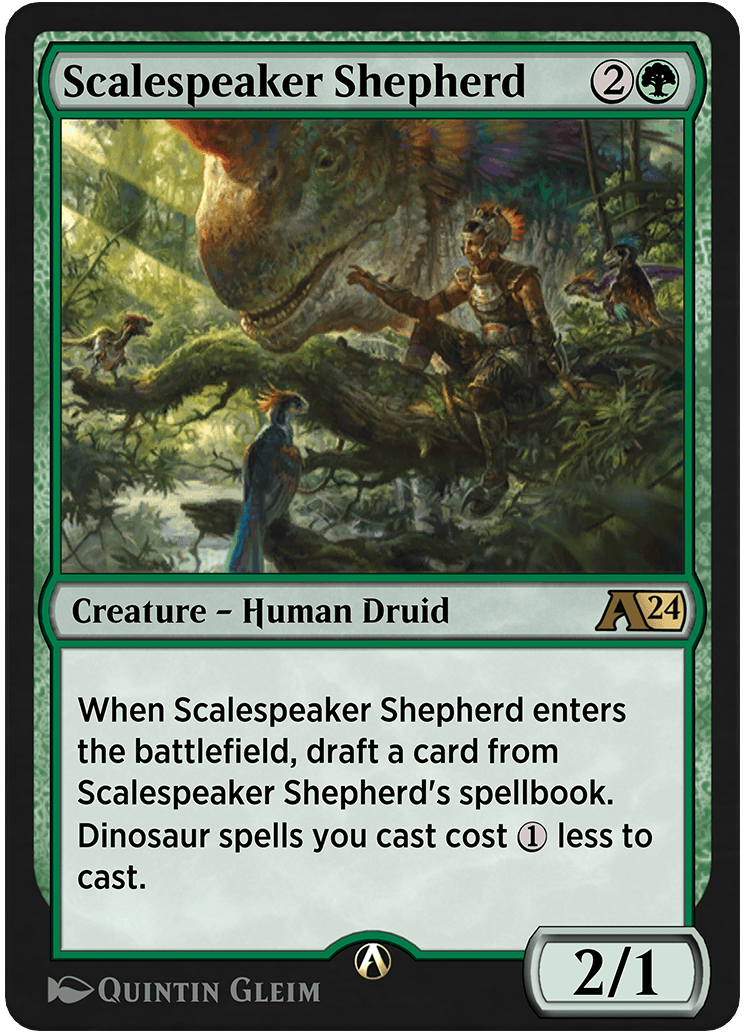
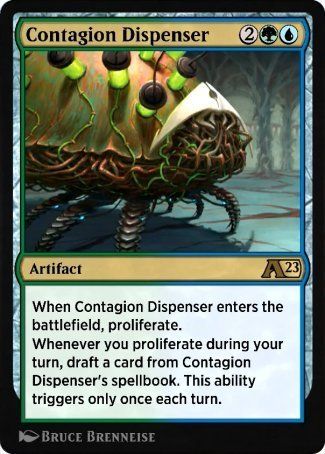
Alchemy also allows for new mechanics that aren’t available in Standard, including the spellbook mechanic. This mechanic allows players to draft a card from a “spellbook” when a condition is met, like a creature entering the battlefield with Scalespeaker Shepherd or proliferating on your turn with Contagion Dispenser.
Alchemy has occasional events as well as its own queue on the MTG Arena play blade that offers both best of one and traditional match modes, ranked and unranked play. This is just like to how Standard and Historic operate in terms of working off of your single constructed ranking.
Rebalancing in Alchemy
Rebalancing cards is the main driver of Alchemy’s creation. It’s what makes the format unique and allows for it to be a consistently fresh and unique format for players to enjoy. Rebalancing cards works in an intuitive way. The most important thing to know is that rebalanced cards are only rebalanced in Alchemy and Historic.
A huge issue that causes controversy in the community when it comes to Alchemy and its ambitious rebalancing is the fact that these changes also impact Historic. Cards that dominated in Standard, get nerfed, and are also nerfed in Historic. Since the cards are playable in multiple formats, Wizards opted not to refund any wildcards for these cards.
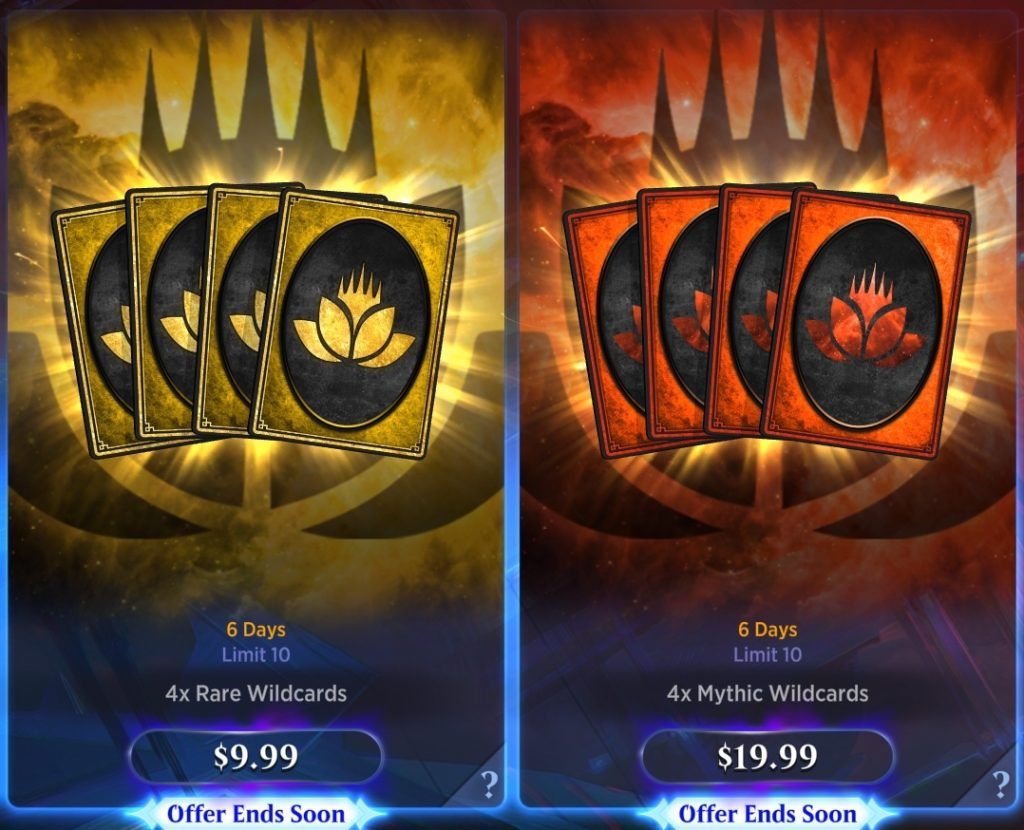
This has caused many content creators in the Magic community to speak out and express concern that their cards have been nerfed without compensation.
This is definitely a cause for concern for the average MTG Arena player who doesn’t have the ability to spend hundreds of dollars on the game to keep an up-to-date deck in multiple formats. If anything, a separate rebalancing style similar to that of Alchemy’s would make much more sense for Historic instead of just carrying over rebalances for Standard into a separate evergreen format.
Alchemy Banlist
Thankfully, there are no cards banned in Alchemy.
When Will Alchemy Next Rotate?
Usually in September. The sets in Alchemy rotate on their own schedule, one year shorter than Standard. New Alchemy sets will be playable for two years, alongside the set they were released with, then rotate out.
The evergreen MTG Arena base set never rotates out since it’s the eternal core set for the digital platform.
Alchemy vs. Standard
Since Standard needs to be consistent across paper, MTGO, and Arena, there are some key differences between it and Alchemy. First and most importantly is that Standard doesn’t get card “rebalances” since you can’t retroactively change what a card does in paper like you can in a digital-only format. Wizards has done this with mechanics like interrupts and other errata text, but never to the scale or frequency in which they do it with Alchemy.
Standard also doesn’t have access to the Arena base set or the supplement Alchemy sets, which means a narrower range of top tier decks regardless of rebalances.
There’s also a certain level of risk and cost for non-whale Arena players with Alchemy that Standard doesn’t have.
This is the worst part about the format. The fact that players aren’t getting wildcard refunds for rebalances is absurd and unheard of in terms of other digital card games.
Finally, if you already own a copy of a card in Standard, you also own it in Alchemy, even if it’s rebalanced. If you own a copy in one format, you own a copy in the other. This is how it should be considering they’re effectively the same card until rebalanced.
Alchemy Unique Mechanics
Since Alchemy is a digital-only format, WotC expands on digital-only mechanics. There are a few you need to know before you dive into deckbuilding, so be sure to learn about all the digital-only mechanics, beyond what we go thorugh here.
Boon
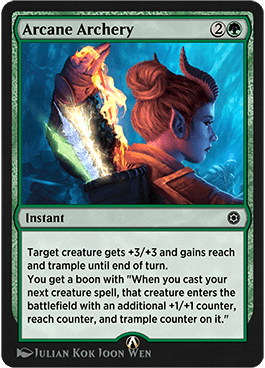
Boons are very similar to emblems in MTG, but are instead temporary and originate as an effect of another card, rather than something you gain from a planeswalker ability. One example is Arcane Archery, which gives you a boon that buffs your next creature. It's most commonly used to set up chain effects to get additional value out of cards, but are also very easy to play around.
Conjure
Conjure was first introduced in Jumpstart: Historic Horizons. It works as a way to generate entirely new cards into your hand.
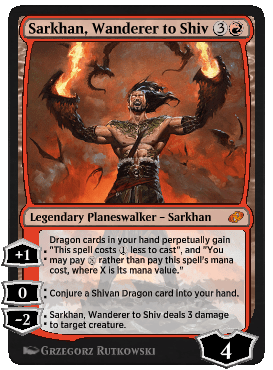
Let’s take Sarkhan, Wanderer to Shiv as an example. This planeswalker’s 0 ability conjures a Shivan Dragon card into your hand out of thin air. It doesn’t grab it from your sideboard or your library, just puts it into your hand. This means it can be bounced, go to the graveyard, etc.
This obviously can’t be done in paper Magic, which is why it’s exclusive to digital.
Double Team
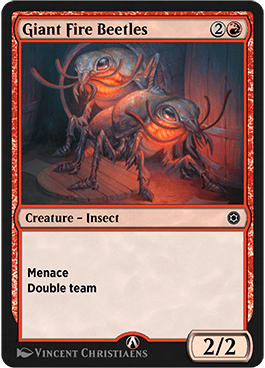
Double team is a simple, digital-only mechanic that allows you to essentially get two creatures in one. Whenever a creature with double team attacks, as long as it isn't a token, you conjure a duplicate copy into your hand. Then, both copies lose the double team mechanic. Overall, it requires a decent amount of setup, and since it doesn't chain multiple times, it just isn't that great.
Draft / Spellbook
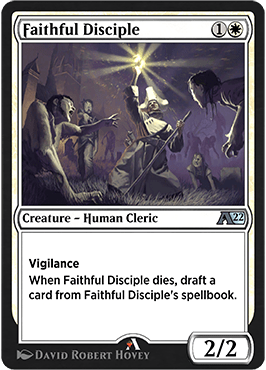
A “spellbook” is a set of 15 cards tied to cards that have the spellbook mechanic. The mechanic allows players to draft a single card from three randomly determined choices out of the 15 when a certain condition is met. Each spellbook card has a unique set of 15 cards to choose from. This mechanic is meant to be like learn without need for sideboard and with a much wider range of options per card.
For example, Faithful Disciple gives you 15 cards with an enchantment theme to choose from when it dies. Your spellbook options include things like Banishing Light, Teleportation Circle, and even Cathars' Crusade.
Intensity
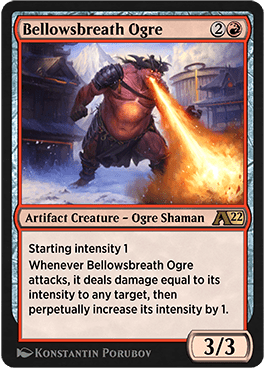
Intensity is a fairly straight-forward mechanic. Your creature starts with a certain intensity, has an effect that depends on its intensity level, and then grows in intensity after certain effects take place. On Bellowsbreath Ogre, for instance, you get to deal direct damage to any target equal to its intensity, and that number goes up whenever it attacks. It's very similar to any sort of continuous +1/+1 counter effect but can make use of Alchemy's digital-only mechanics like perpetually.
Perpetually
Perpetually does exactly what you assume it does; it permanently alters a specific card for the duration of the game, regardless of zone changes. The mechanic itself isn’t impossible to employ in paper play, but it is vastly easier to do (and track) on a digital platform.
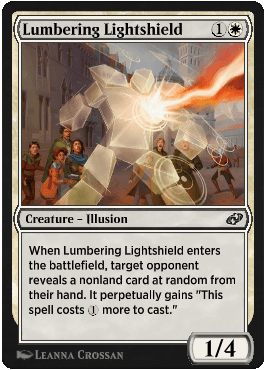
Lumbering Lightshield is a good example of the keyword in use. This creature randomly makes a nonland card in your opponent’s hand cost an extra colorless mana for the rest of the game. This doesn’t hit every single copy of the card, just the specific one that you reveal with the spell.
Seek
Seek is a mechanic that randomly tutors out a specific card or type of card from your library when its condition is fulfilled. The fun thing is that it does not require the library to be shuffled since you’re not looking through your library to find the tutored card yourself. The game automatically resolves the actions for you.
Seek is meant to be a mechanic that’s consistent but not repetitive. Wizards wants you to be able to reasonably build around seek without having a guaranteed choice every single time.
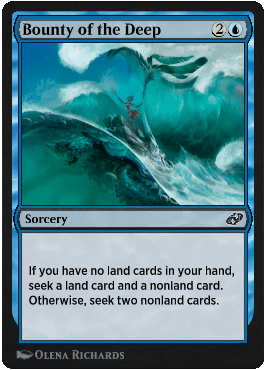
Bounty of the Deep is an example of a card with seek. This card seeks either a nonland and a land card or two totally random nonland cards depending on your current hand.
Specialize
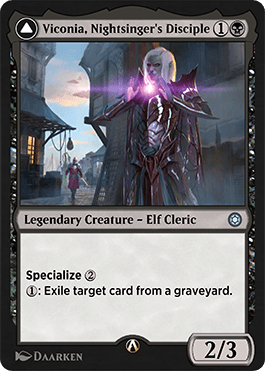
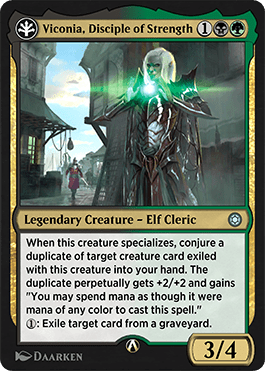
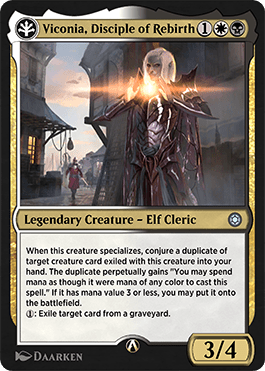
Specialize is another mechanic designed specifically for Alchemy. It allows legendary creatures to add to their color identity as well as a new mechanic based on which selection you make when activating the ability. Each color variant of the original also has its own parallel art background.
How Does Duplicate Protection Work in Alchemy?
Duplication protection works a little differently for boosters of Alchemy supplemental sets than regular packs. Each set will be tied with an existing Standard set. For example, Alchemy: Innistrad is tied with Crimson Vow.
When you open a pack of Alchemy: Innistrad and you’ve collected a full playset of all rares in the supplemental set, you won’t get the 20 gems that duplicate protection promises. Instead you’ll get a Crimson Vow rare. This continues until you’ve collected full playsets of both sets. Then you get your gems. The same goes for mythic rares, except you’ll get 40 gems once you’ve finally collected full playsets of both Alchemy: Innistrad and Crimson Vow mythics.
What About Crafting?
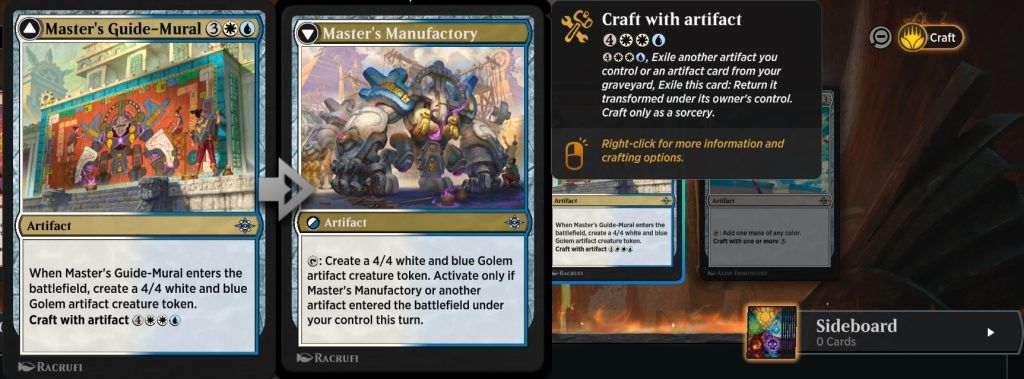
Crafting any version of a Standard card also gives you all the existing versions. It doesn’t matter which version you craft first; there’s no need to collect them separately.
This is great because it lets players use the lowest number of wildcards possible.
Also, Alchemy-exclusive cards can be crafted at the normal wildcard rate, so this could potentially end up burning more of your wildcards.
Where to Play Alchemy
Alchemy is exclusive to MTG Arena and won’t be on MTG Online. This can be attributed to a few things. The first is that WotC is putting a lot of support behind Arena reaching a broad audience, and part of that is creating more MTGA-exclusive content. The second is that Alchemy includes cards from the Arena base set, which isn’t available on MTGO. There’s also no way to rebalance cards on MTGO, which completely defeats Alchemy’s purpose.
Top Alchemy Decks
It's hard to pinpoint a deck that dominates since Alchemy is an everchanging format. The same could be said about the cards as they're constantly “buffed” or “nerfed.”
That said, there are still some cards that are good without being broken. Here are some examples of balanced cards that see play in multiple decks.
Sheoldred, the Apocalypse
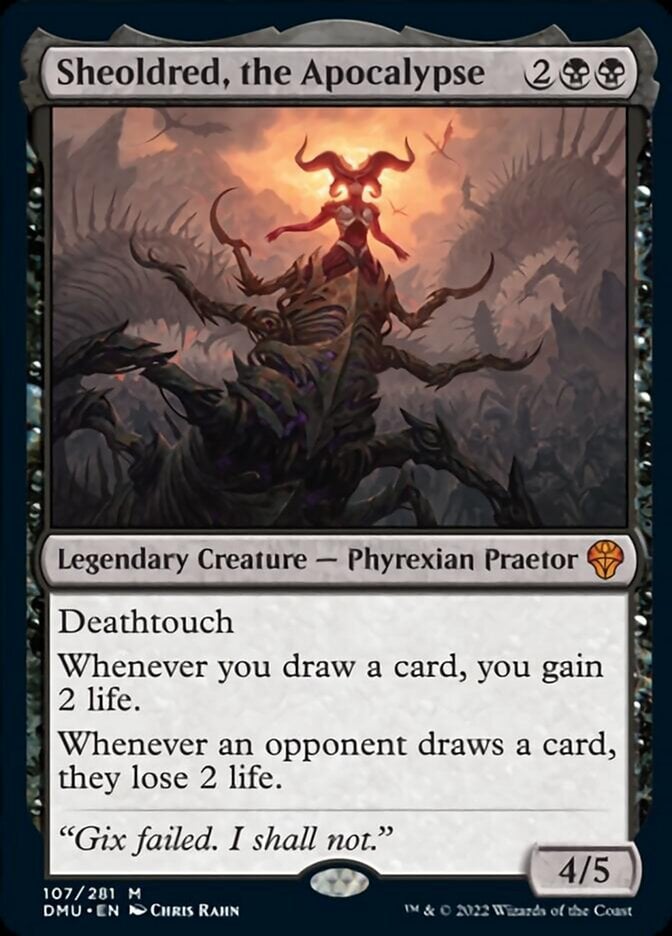
Sheoldred, the Apocalypse is a powerhouse, and it's no wonder how good it is in every format it has touched; Alchemy is no exception. From Esper decks to Grixis ones, this Phyrexian is a must-have when it comes to deck building. Even decks like Golgari Midrange benefit from having it as an option thanks to how good it is at pressuring your opponents' life totals and also stabilizing your life total if it manages to survive. Often paired with The One Ring, which, despite getting nerfed, is still seeing tons of play in the format.
Monastery Swiftspear
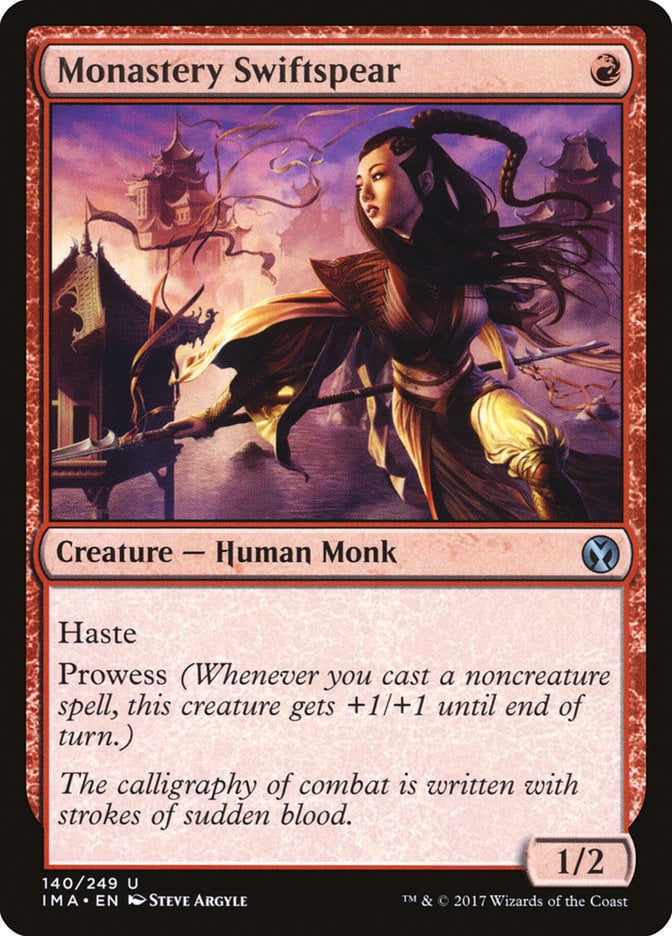
When it comes down to “budget” staples for Alchemy, Monastery Swiftspear is a safe card to craft, whether or not you use it in streamlined aggro decks such as Boros or mono-red, or tempo-oriented ones like Izzet. This card always overperforms in the right deck and can start pressuring your opponents from turn one. If unanswered, your opponents will be in a lot of trouble, especially when there are multiple copies of the monk on the field.
Juggernaut Peddler
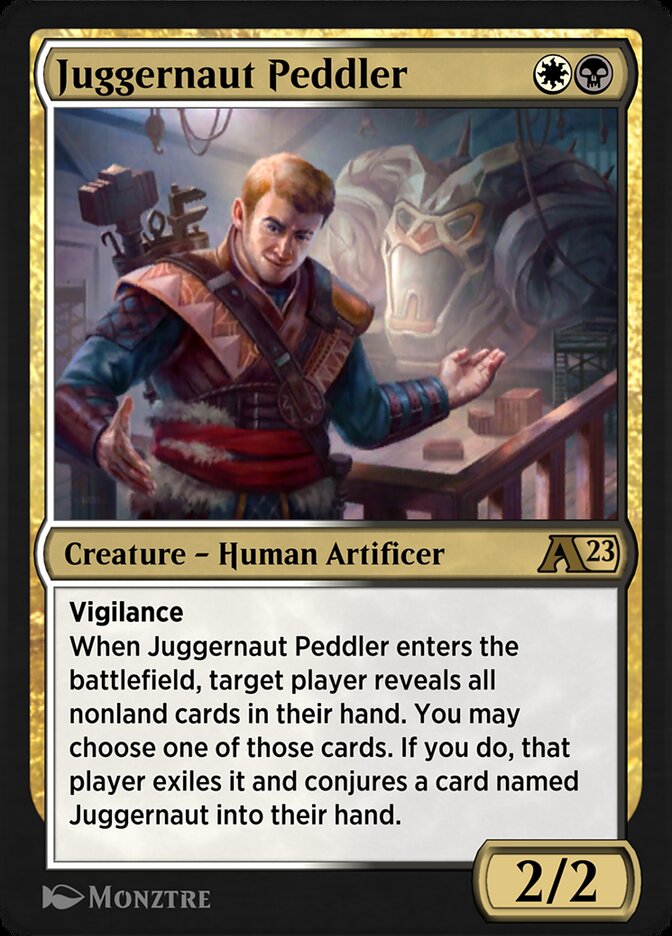
A card that has recently risen in popularity is Juggernaut Peddler. For two mana, you get to remove your opponent's best card from their hand and replace it with a seemingly useless creature. When paired with the likes of Deep-Cavern Bat, it frustrates your opponents as their hand gets decimated little by little.
Orzhov Midrange

Raddic, Tal Zealot | Illustrated by Camille Alquier
Creature (17)
Juggernaut Peddler x4
Deep-Cavern Bat x3
Preacher of the Schism x4
Gix, Yawgmoth Praetor x2
Raddic, Tal Zealot
Sheoldred, the Apocalypse x3
Instant (4)
Enchantment (11)
Virtue of Loyalty x4
Virtue of Persistence x3
Porcine Portent x4
Artifact (1)
Land (27)
Barad-dûr
Captivating Crossroads x4
Caves of Koilos x4
Minas Tirith
Mirrex x3
Plains x5
Restless Fortress x4
Swamp x5
Sideboard (14)
Loran of the Third Path
Raddic, Tal Zealot
Duress x2
Sunfall
Elspeth's Smite x2
Cut Down x4
Palantír of Orthanc
Phantasmal Extraction x2
Orzhov decks tend to control the game with their perfect removal and hand disruption suite.
From there, it's just a matter of sticking some of your card advantage engines into play, such as Preacher of the Schism or Gix, Yawgmoth Praetor, to get ahead of your opponents in resources while you keep disrupting their plans.
Gruul Dinosaurs
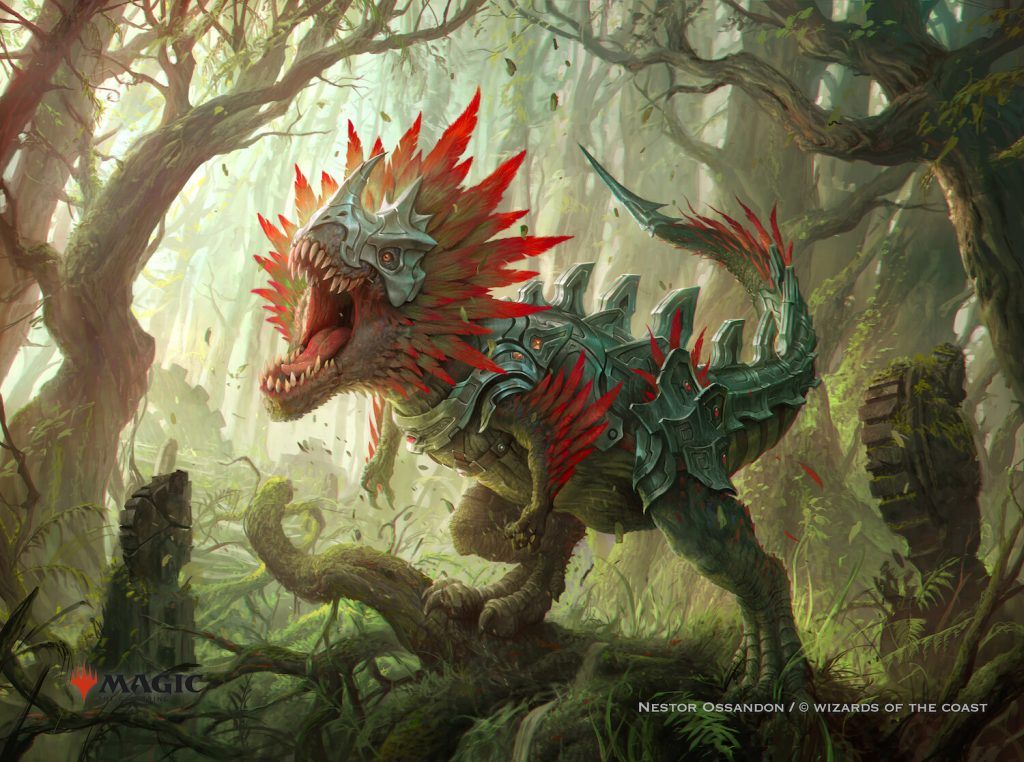
Hulking Raptor | Illustrated by Nestor Ossandon Leal
Creature (38)
Delighted Halfling x4
Itzquinth, Firstborn of Gishath x3
Bramble Familiar x4
Intrepid Paleontologist x4
Huatli, Poet of Unity x4
Hulking Raptor x4
Oliphaunt x4
Trumpeting Carnosaur x4
Generous Ent x4
Etali, Primal Conqueror x3
Artifact (4)
Land (18)
Copperline Gorge x4
Forest x6
Karplusan Forest x4
Mountain x3
Wooded Ridgeline
Sideboard (15)
Wrenn and Realmbreaker x4
Tranquil Frillback x3
Thrun, Breaker of Silence x2
Triumphant Chomp x4
A-Haywire Mite x2
Aggro decks have risen in popularity, as many cards like The One Ring or the Orcish Bowmasters got nerfed from the previous meta. The idea of the Gruul Dinosaurs is to use mana dorks to cheat into play, powerful creatures that have an insane ETB effect, such as Trumpeting Carnosaur or the mighty Etali, Primal Conqueror. However, that is not the only route this deck can carve out, as other creatures like Hulking Raptor present a decent threat on their own. If you manage to resolve them a turn earlier, your opponents will be in trouble.
Mono-Red
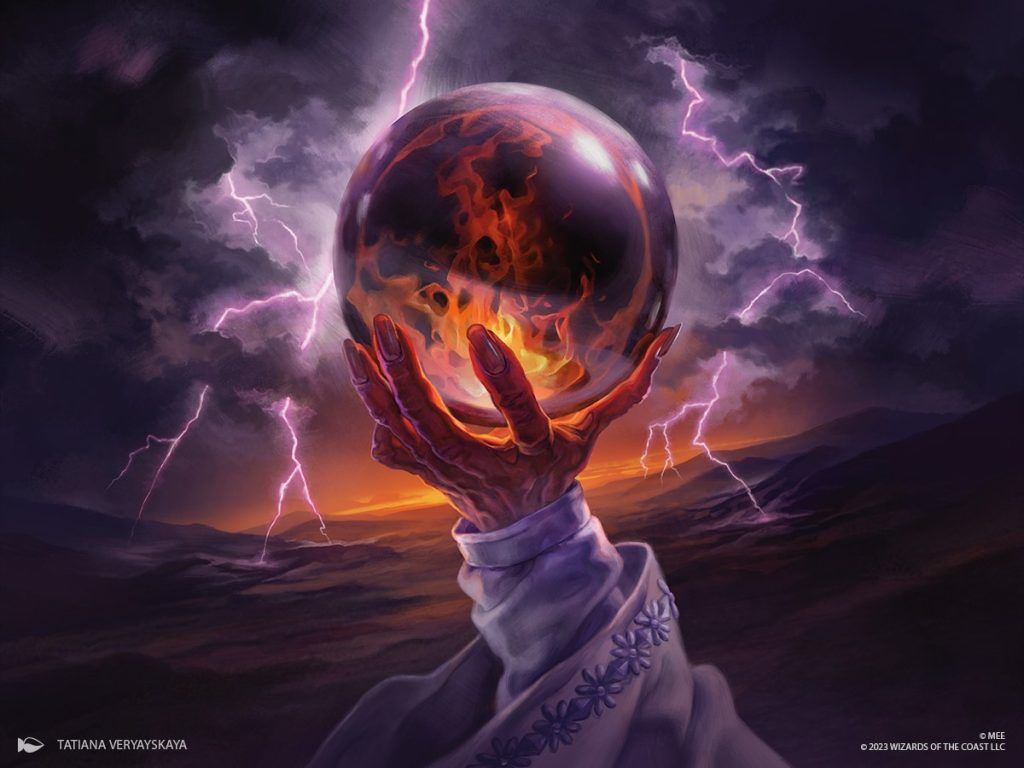
Palantír of Orthanc The Lord of the Rings Tales of Middle-earth | Illustrated by Tatiana Veryayskaya
Creature (20)
Shivan Devastator x2
Monastery Swiftspear x4
Phoenix Chick x4
Charming Scoundrel x4
Imodane's Recruiter x4
Squee, Dubious Monarch x2
Sorcery (7)
Song of Totentanz
Rally at the Hornburg x4
Twisted Fealty x2
Instant (8)
Monstrous Rage x4
Lightning Strike x4
Artifact (2)
Land (23)
Battlefield Forge x4
Mishra's Foundry x3
Mountain x16
Sideboard (15)
Koth, Fire of Resistance x3
Fear, Fire, Foes!
Obliterating Bolt
Nahiri's Warcrafting x2
Torch the Tower x3
Kayla's Kindling x2
Urabrask's Forge x3
Mono-red is the deck that’s always present in any format. Most of the time it's because it's cheap rather than good. But that's not the case in Alchemy; this version of mono red is very powerful.
If you’re looking to rank up fast, especially in best of one, this is a cheap and powerful deck you should try to get your hands on.
Alchemy Products and Boosters

Cards that are legal in Standard are also legal in Alchemy, but there are still some Alchemy-specific cards that you may need to get your hands on.
Boosters can be bought directly from the Arena Store at the same rate as Standard packs.
Alchemy Communities
Many of the same Magic communities where you can talk about Standard or Historic are also open to Alchemy. Here are a few options if you’re not sure where to start:
- Our very own Draftsim Discord has a dedicated Alchemy text channel where players have been discussing the format and what they’re finding the most fun!
- r/MagicArena is a great place to discuss Alchemy since it’s an Arena-only format.
- The official MTG Arena Discord is another great place to find like-minded deckbuilders and theory crafters. You can find text channels for casual and competitive Alchemy over there.
Wrap Up
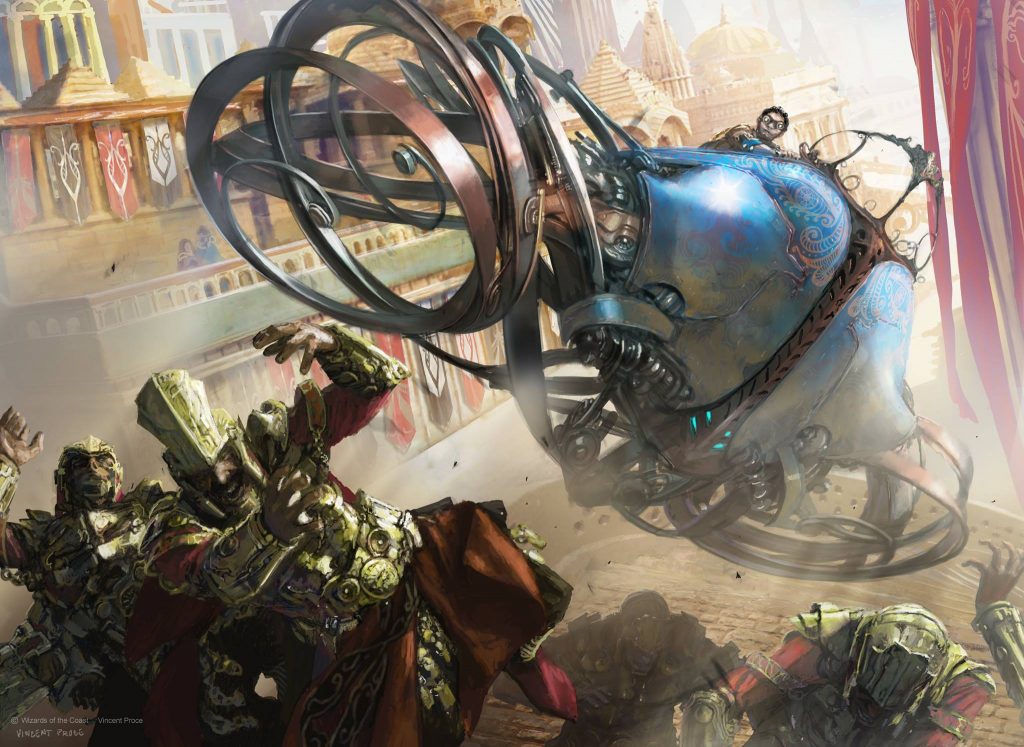
Leave in the Dust | Illustration by Vincent Proce
This is everything you need to know about Alchemy.
What do you think of the format? Do you think having more digital-exclusive cards and formats healthy for the game? Is it bringing the end times for Magic, is it thrusting us into a prosperous future, or is it mostly irrelevant? Let me know what you think in the comments, and don’t forget to grab Arena Tutor before you head to MTGA. All of your cards get locked and loaded, and the software is ready to track your matches and help you improve your games.
Until next time, stay safe, and stay healthy!
Follow Draftsim for awesome articles and set updates:
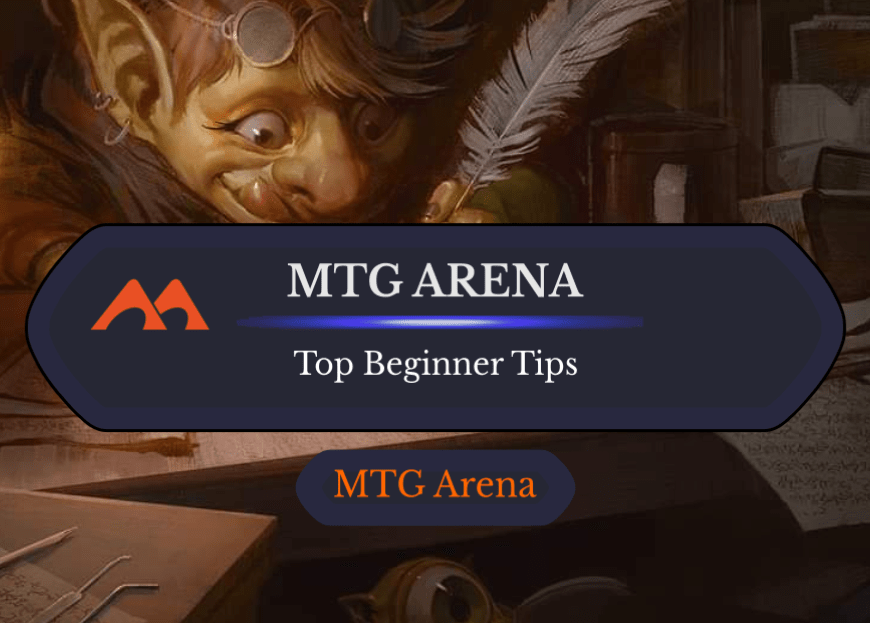
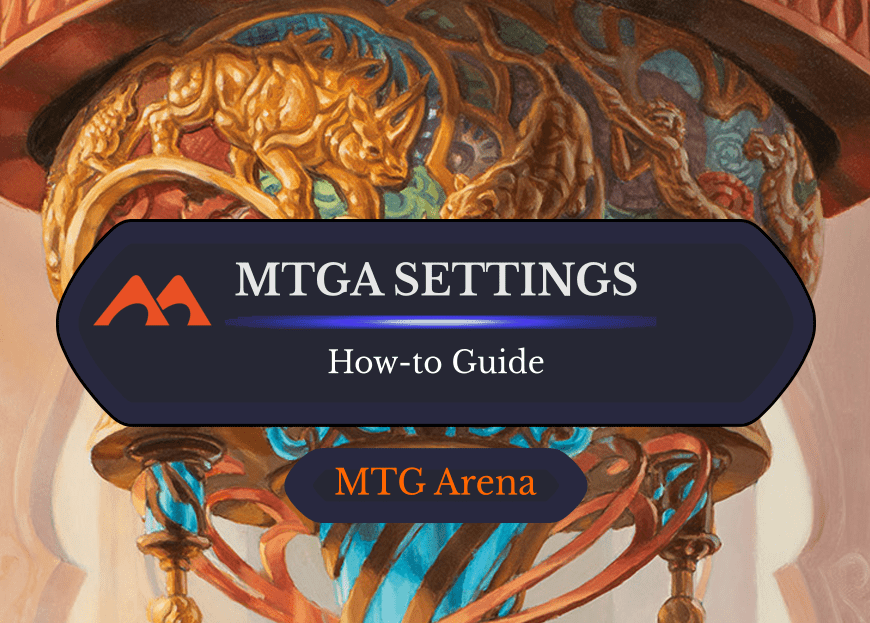
2 Comments
This is great information. But I do have a question. I have 3 decks that I cant play in the alchemy format because each deck has one card that I cannot remove one card from so I was wondering how to remove those specific cards so that I can play them in the alchemy format??
I would just export the deck, edit the list, re-copy it, then import it into a new deck with a different format.
Add Comment